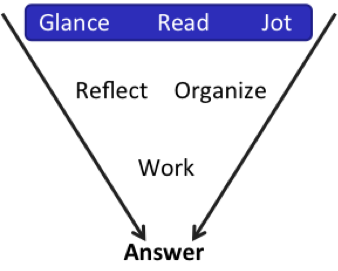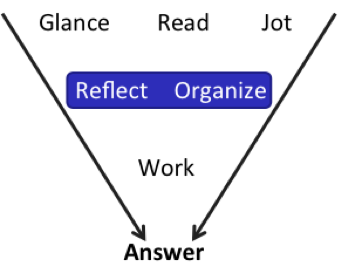-
Target Test Prep 20% Off Flash Sale is on! Code: FLASH20
Redeem
GMAT Data Sufficiency: Follow Your Process - Part 1
 Data Sufficiency problems are fantastic because you can avoid doing lots of math calculations! Data Sufficiency problems are really annoying because theyre so tricky; its very easy to fall into a trap. :(
Data Sufficiency problems are fantastic because you can avoid doing lots of math calculations! Data Sufficiency problems are really annoying because theyre so tricky; its very easy to fall into a trap. :(
So how do we take advantage of the benefits of DS without falling prey to the test-writers tricks?
Try this GMATPrep problem from the free problem sets and then well talk!
*If both x and y are nonzero numbers, what is the value of [pmath]y/x[/pmath]?(1) x = 6
(2) [pmath]y^2=x^2[/pmath]
(Wondering where the answer choices are? I havent put them here. If you haven't done enough DS to know what the answer choices are already, then dont start with this article. Start here.)
Got your answer? Okay, lets get started.
Glance at the problem. Its DS! Draw a T on your scrap paper and jot down the relevant info as you read. Also note that the information looks pretty straightforward in both the question stem and the statementsso work methodically. Dont get sloppy and make a careless mistake.
Now what? You could go straight to the statements and start working, but reflect a moment.
What would be sufficient to answer that question?
If they tell me the values for x and y individually, then I can answer the question. Or if they tell me the value of the quantity or combination [pmath]y/x[/pmath], then I can also answer the question.
Okay, lets do this.
That first statement tells me x but nothing about y, either alone or in relation to x. Thats not sufficient. What about the second one?
Careful! Trap number 1 is lurking. Forget what you saw in statement (1). It doesnt exist.
Next, can you manipulate that equation? Lets see.
[pmath]y^2/x^2=1[/pmath]
Does that mean that just plain[pmath]y/x[/pmath]is also 1? Maybe. But not necessarily! Heres trap number 2.
Either one of the base variables could be negative. For instance, x could be 3 and y could be -3. If so, then the answer would be 1, not +1. This one is really tempting, but its not enough on its own. This statement is not sufficient.
What happens when we put them together?
Finally, this one must be sufficient, right?
Nope! This is trap #3. Its true that x = 6, but y could still be +6 or 6, so the answer is either 1 or 1. Thats not sufficient; for a value question, there has to be just one answer.
The correct answer is (E).
The math on this problem is not super-advanced. The question is definitely a beautiful question thoughat least, from the point of view of the test writer. :) They set two traps to steer you towards choice (B) and a third trap to steer you towards choice (C), all in a problem that looked pretty straightforward at first glance. Now imagine how mentally fatigued youre going to get as the test progresses and you can see how easy it might be to fall into one of these traps without even realizing it.
Check back next time when we'lladd a few more process layers that are specific to DS.
Key Takeaways for Data Sufficiency:
(1) Have a consistent process and stick to it. The process I describe in this article is the one I use, but you dont have to use mine. Whatever you do use, just make sure that it clearly delineates the various steps you need to take and that you always follow the same steps, every time.
(2) Dont rush when you think something is easy! Speed causes careless mistakes. When you know how to do something, make sure you get that point. Save rushing for the ones that are really hard! Chances are good that well get those wrong anyway; we might as well get them wrong faster.
* GMATPrep questions courtesy of the Graduate Management Admissions Council. Usage of this question does not imply endorsement by GMAC.
Recent Articles
Archive
- April 2024
- March 2024
- February 2024
- January 2024
- December 2023
- November 2023
- October 2023
- September 2023
- July 2023
- June 2023
- May 2023
- April 2023
- March 2023
- February 2023
- January 2023
- December 2022
- November 2022
- October 2022
- September 2022
- August 2022
- July 2022
- June 2022
- May 2022
- April 2022
- March 2022
- February 2022
- January 2022
- December 2021
- November 2021
- October 2021
- September 2021
- August 2021
- July 2021
- June 2021
- May 2021
- April 2021
- March 2021
- February 2021
- January 2021
- December 2020
- November 2020
- October 2020
- September 2020
- August 2020
- July 2020
- June 2020
- May 2020
- April 2020
- March 2020
- February 2020
- January 2020
- December 2019
- November 2019
- October 2019
- September 2019
- August 2019
- July 2019
- June 2019
- May 2019
- April 2019
- March 2019
- February 2019
- January 2019
- December 2018
- November 2018
- October 2018
- September 2018
- August 2018
- July 2018
- June 2018
- May 2018
- April 2018
- March 2018
- February 2018
- January 2018
- December 2017
- November 2017
- October 2017
- September 2017
- August 2017
- July 2017
- June 2017
- May 2017
- April 2017
- March 2017
- February 2017
- January 2017
- December 2016
- November 2016
- October 2016
- September 2016
- August 2016
- July 2016
- June 2016
- May 2016
- April 2016
- March 2016
- February 2016
- January 2016
- December 2015
- November 2015
- October 2015
- September 2015
- August 2015
- July 2015
- June 2015
- May 2015
- April 2015
- March 2015
- February 2015
- January 2015
- December 2014
- November 2014
- October 2014
- September 2014
- August 2014
- July 2014
- June 2014
- May 2014
- April 2014
- March 2014
- February 2014
- January 2014
- December 2013
- November 2013
- October 2013
- September 2013
- August 2013
- July 2013
- June 2013
- May 2013
- April 2013
- March 2013
- February 2013
- January 2013
- December 2012
- November 2012
- October 2012
- September 2012
- August 2012
- July 2012
- June 2012
- May 2012
- April 2012
- March 2012
- February 2012
- January 2012
- December 2011
- November 2011
- October 2011
- September 2011
- August 2011
- July 2011
- June 2011
- May 2011
- April 2011
- March 2011
- February 2011
- January 2011
- December 2010
- November 2010
- October 2010
- September 2010
- August 2010
- July 2010
- June 2010
- May 2010
- April 2010
- March 2010
- February 2010
- January 2010
- December 2009
- November 2009
- October 2009
- September 2009
- August 2009

